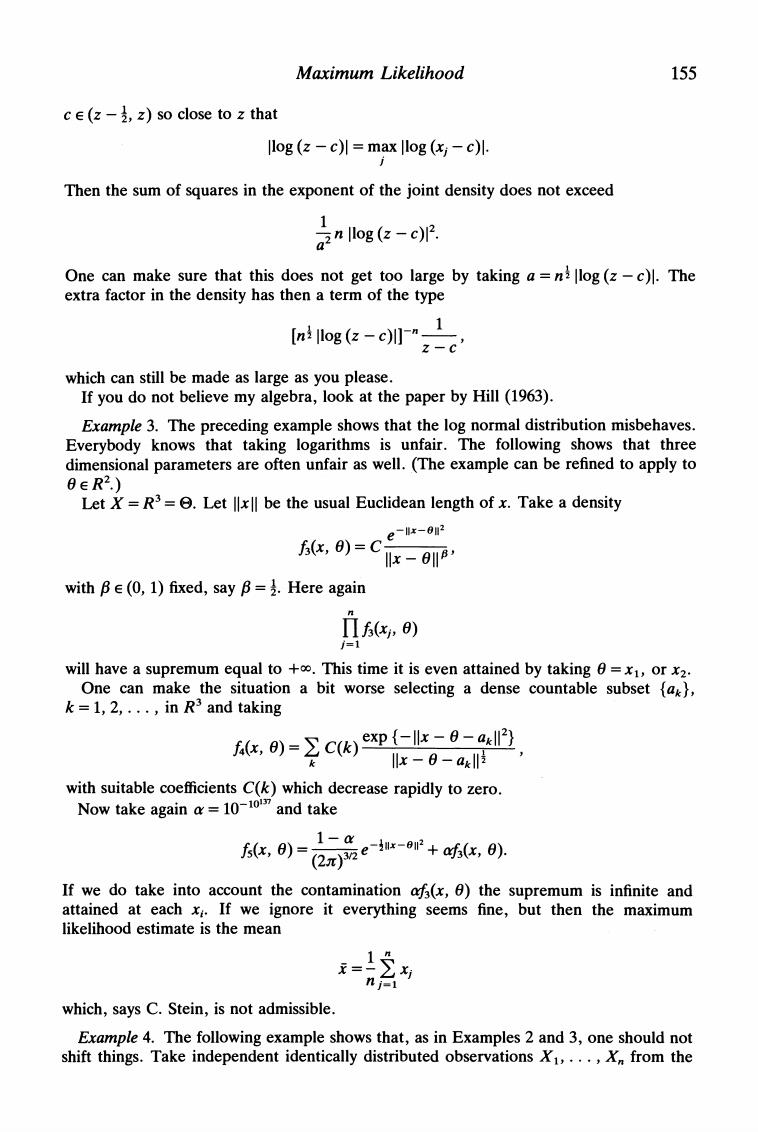正在加载图片...

Maximum Likelihood 155 ce(z-2,z)so close to z that llog (z-c)=max llog (x-c) Then the sum of squares in the exponent of the joint density does not exceed azn llog (z-c)2 One can make sure that this does not get too large by taking a=nllog(z-c).The extra factor in the density has then a term of the type [og(z-c训1 -c' which can still be made as large as you please. If you do not believe my algebra,look at the paper by Hill(1963). Example 3.The preceding example shows that the log normal distribution misbehaves. Everybody knows that taking logarithms is unfair.The following shows that three dimensional parameters are often unfair as well.(The example can be refined to apply to 0∈R2) Let X=R3=e.Let xll be the usual Euclidean length of x.Take a density i6,8)=ce-o2 llx-e118' with Be(0,1)fixed,say B=.Here again 5,6) =1 will have a supremum equal to +This time it is even attained by taking 6=x1,or x2. One can make the situation a bit worse selecting a dense countable subset {ak}, k=1,2,...,in R3 and taking f6,)-∑ck)exp{-r-6-4的 x-8-akl吃 with suitable coefficients C(k)which decrease rapidly to zero. Now take again a=10-101and take 1-a f5x,)= 2me-r+a6k,0). If we do take into account the contamination afa(,e)the supremum is infinite and attained at each x.If we ignore it everything seems fine,but then the maximum likelihood estimate is the mean n i=1 which,says C.Stein,is not admissible. Example 4.The following example shows that,as in Examples 2 and 3,one should not shift things.Take independent identically distributed observations X1,...,X from theMaximum Likelihood c e (z - 1, z) so close to z that Ilog (z - c)l = max Ilog (xj - c)l. i Then the sum of squares in the exponent of the joint density does not exceed 1n 1log (z - c)12. One can make sure that this does not get too large by taking a = n |log (z - c)l. The extra factor in the density has then a term of the type [n? log (z - c)l]-n - c which can still be made as large as you please. If you do not believe my algebra, look at the paper by Hill (1963). Example 3. The preceding example shows that the log normal distribution misbehaves. Everybody knows that taking logarithms is unfair. The following shows that three dimensional parameters are often unfair as well. (The example can be refined to apply to 0eR2.) Let X = R3 = O. Let lIxll be the usual Euclidean length of x. Take a density -fllx-0112 IIx - 011' with 3 e (0, 1) fixed, say / = -.Here again n If3(xj, 0) j=1 will have a supremum equal to +o0. This time it is even attained by taking 0 = xi, or x2. One can make the situation a bit worse selecting a dense countable subset {ak}, k = 1, 2,..., in R3 and taking f4(x, 0)= C(k) exp (-llx - 0- ak112} k IIx - 0 - ak II' with suitable coefficients C(k) which decrease rapidly to zero. Now take again a = 101-137 and take f5(x, 0) = (2r)32 e + of3(x, e). If we do take into account the contamination af3(x, 0) the supremum is infinite and attained at each xi. If we ignore it everything seems fine, but then the maximum likelihood estimate is the mean n nj=1 which, says C. Stein, is not admissible. Example 4. The following example shows that, as in Examples 2 and 3, one should not shift things. Take independent identically distributed observations X, .. ., Xn from the 155